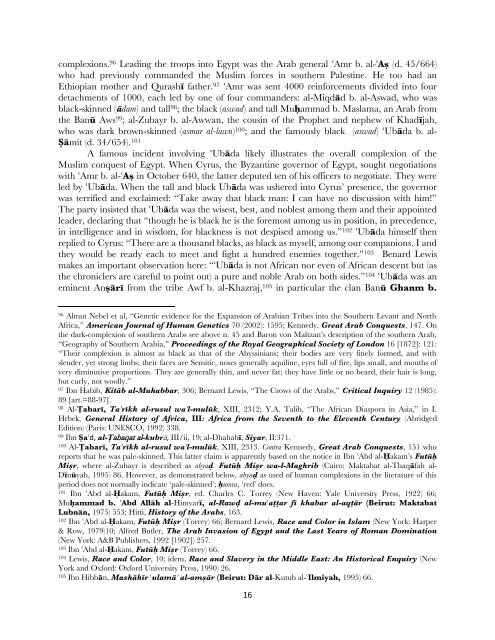Muhammad_Article.349.. - Dr. Wesley Muhammad
Muhammad_Article.349.. - Dr. Wesley Muhammad
Muhammad_Article.349.. - Dr. Wesley Muhammad
Create successful ePaper yourself
Turn your PDF publications into a flip-book with our unique Google optimized e-Paper software.
complexions. 96 Leading the troops into Egypt was the Arab general #Amr b. al-#Aß (d. 45/664)<br />
who had previously commanded the Muslim forces in southern Palestine. He too had an<br />
Ethiopian mother and QurashÊ father. 97 #Amr was sent 4000 reinforcements divided into four<br />
detachments of 1000, each led by one of four commanders: al-Miqd§d b. al-Aswad, who was<br />
black-skinned (§dam) and tall 98 ; the black (aswad) and tall MuÈammad b. Maslama, an Arab from<br />
the Banå Aws 99 ; al-Zubayr b. al-Awwan, the cousin of the Prophet and nephew of KhadÊjah,<br />
who was dark brown-skinned (asmar al-lawn) 100 ; and the famously black (aswad) #Ub§da b. al-<br />
Ԥmit (d. 34/654). 101<br />
A famous incident involving #Ub§da likely illustrates the overall complexion of the<br />
Muslim conquest of Egypt. When Cyrus, the Byzantine governor of Egypt, sought negotiations<br />
with #Amr b. al-#Aß in October 640, the latter deputed ten of his officers to negotiate. They were<br />
led by #Ub§da. When the tall and black Ub§da was ushered into Cyrus’ presence, the governor<br />
was terrified and exclaimed: “Take away that black man: I can have no discussion with him!”<br />
The party insisted that #Ub§da was the wisest, best, and noblest among them and their appointed<br />
leader, declaring that “though he is black he is the foremost among us in position, in precedence,<br />
in intelligence and in wisdom, for blackness is not despised among us.” 102 #Ub§da himself then<br />
replied to Cyrus: “There are a thousand blacks, as black as myself, among our companions. I and<br />
they would be ready each to meet and fight a hundred enemies together.” 103 Benard Lewis<br />
makes an important observation here: “#Ub§da is not African nor even of African descent but (as<br />
the chroniclers are careful to point out) a pure and noble Arab on both sides.” 104 #Ub§da was an<br />
eminent AnߧrÊ from the tribe Awf b. al-Khazraj, 105 in particular the clan Banå Ghanm b.<br />
96 Almut Nebel et al, “Genetic evidence for the Expansion of Arabian Tribes into the Southern Levant and North<br />
Africa,” American Journal of Human Genetics 70 (2002): 1595; Kennedy, Great Arab Conquests, 147. On<br />
the dark-complexion of southern Arabs see above n. 45 and Baron von Maltzan’s description of the southern Arab,<br />
“Geography of Southern Arabia,” Proceedings of the Royal Geographical Society of London 16 [1872]: 121:<br />
“Their complexion is almost as black as that of the Abyssinians; their bodies are very finely formed, and with<br />
slender, yet strong limbs; their faces are Semitic, noses generally aquiline, eyes full of fire, lips small, and mouths of<br />
very diminutive proportions. They are generally thin, and never fat; they have little or no beard, their hair is long,<br />
but curly, not woolly.”<br />
97 Ibn Habib, Kit§b al-Muhabbar, 306; Bernard Lewis, “The Crows of the Arabs,” Critical Inquiry 12 (1985):<br />
89 [art.=88-97].<br />
98 Al-•abarÊ, Ta"rÊkh al-rusul wa"l-mulåk, XIII, 2312; Y.A. Talib, “The African Diaspora in Asia,” in I.<br />
Hrbek, General History of Africa, III: Africa from the Seventh to the Eleventh Century (Abridged<br />
Edition) (Paris: UNESCO, 1992) 338.<br />
99 Ibn ‘a#d, al-•abaqat al-kubr§, III/ii, 19; al-DhahabÊ, Siyar, II:371.<br />
100 Al-•abarÊ, Ta"rÊkh al-rusul wa"l-mulåk, XIII, 2313. Contra Kennedy, Great Arab Conquests, 151 who<br />
reports that he was pale-skinned. This latter claim is apparently based on the notice in Ibn #Abd al-\akam’s FutåÈ<br />
Mißr, where al-Zubayr is described as abya∙. FutåÈ Mißr wa-l-Maghrib (Cairo: Maktabat al-Thaq§fah al-<br />
DÊnåyah, 1995) 86. However, as demonstrated below, abya∙ as used of human complexions in the literature of this<br />
period does not normally indicate ‘pale-skinned’; Èumra, ‘red’ does.<br />
101 Ibn #Abd al-\akam, FutåÈ Mißr, ed. Charles C. Torrey (New Haven: Yale University Press, 1922) 66;<br />
MuÈammad b. #Abd All§h al-HimyarÊ, al-Raw∙ al-mu#aããar fÊ khabar al-aqã§r (Beirut: Maktabat<br />
Lubn§n, 1975) 553; Hitti, History of the Arabs, 163.<br />
102 Ibn #Abd al-\akam, FutåÈ Mißr (Torrey) 66; Bernard Lewis, Race and Color in Islam (New York: Harper<br />
& Row, 1979)10; Alfred Butler, The Arab Invasion of Egypt and the Last Years of Roman Domination<br />
(New York: A&B Publishers, 1992 [1902]) 257.<br />
103 Ibn #Abd al-\akam, FutåÈ Mißr (Torrey) 66.<br />
104 Lewis, Race and Color, 10; idem, Race and Slavery in the Middle East: An Historical Enquiry (New<br />
York and Oxford: Oxford University Press, 1990) 26.<br />
105 Ibn Hibb§n, Mash§hÊr #ulam§" al-amߧr (Beirut: D§r al-Kutub al-#Ilmiyah, 1995) 66.<br />
16

















